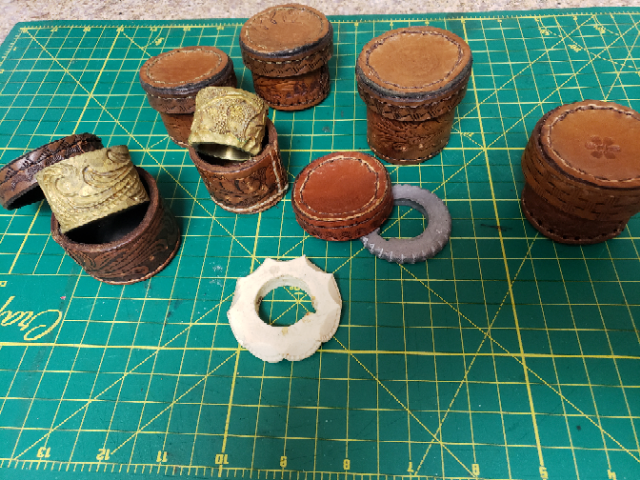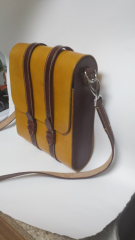-
Posts
1,932 -
Joined
-
Last visited
Content Type
Profiles
Forums
Events
Blogs
Gallery
Everything posted by billybopp
-

Went to buy an embosser, ended up with a few items....
billybopp replied to mogwild's topic in Leather Tools
The belts are looking good @mogwild! I bought the same embosser and a bunch of rolls several years ago when Tandy was discontinuing it, and love it! I've done a number of belts, but there are other uses for it as well. The nice part about this design is that you can run larger pieces of leather through it to emboss the edge! Below are some pics of mug wraps that I've made using the embosser for edges,3D stamps, letter stamps, carving and tooling for the center part: One of the first things that I did with my embosser was to make these little boxes to keep the rolls and small bits like keys in. They are each embossed with the roller that they contain to make them easy to identify. I've attached a picture below . Rolls like the barbed wire are great for borders on skinnier items, and there is probably a plain line roller included with it to leave a nice edge crease, or even make a stitch line. It looks like you have the majority of the original Tandy rolls, so keep your eyes open for new ones (if you're interested). Bunkhouse tools has some inexpensive rolls that will work but the fit isn't perfect so you may need to use a bushing to help keep them from wobbling. They sell on eBay, as do others selling both new and used brass rolls, so give that a look. Just one more thing, be sure to keep the roller shafts dry and even oil them a bit. They are steel and will rust easily. Happy Embossing! - Bill -
Blades for these metal draw gauges are pretty much universal, and fairly inexpensive at about $10 from C.S. Osborne. I have a Civil War era Sauerbier draw gauge, and bought a CSO replacement that fits perfectly. It will need some sharpening, and I suggest rounding off the end of the blade a bit for safety. Alternatively, Terry Kinpschield offers a blade for $45 that will arrive razor sharp. - Bill
-

I found it, I forgot it, I lost it, and then found it again.
billybopp replied to bikermutt07's topic in How Do I Do That?
@bikermutt07 I found it, I forgot it, I lost it, and then found it again. ... Welcome to Senior Moments! ... And thanks for posting this! I was thinking the same thing. As a saddlemaker of some renown, Seidel probably has need of a tool like this on a daily basis, so it would make sense for him to have some bench space permanently devoted to is. For most of the rest of us, some sort of temporary setup makes more sense. I was thinking a piece of wood or plastic with the jig mounted to it then clamped to the table, but I like your idea of using a vice mounted jig even better. Sometimes, the simple ideas are the best ones ... You know, the ones that you see and then think to yourself "Why didn't I think of that?". And that is especially true when it's something as easy to make as this! I've tried different methods for this problem, with the best being a dowel to run the leather against, and holding it down with the same hand holding the tool holds it down which worked OK, but eventually got uncomfortable and let the leather ride up sometimes. I'll be making something like this for sure! - Bill- 20 replies
-
- make easy edges
- beveled edges
-
(and 2 more)
Tagged with:
-
Sad to hear about your friend, but I'm sure he takes comfort in knowing his tools will be used and loved. If he is survived by loved ones, a little gift of something made with those tools as @Grumpymann mentioned above would be a wonderful touch for both him and them. Bill
-
Skive it down a bit thinner and wet before bending should help. Some leathers are just difficult tho. Bill
-

Tandy diamond awl blade a bad thing?
billybopp replied to fistfullofnails's topic in Getting Started
Tandy 4 in 1 is garbage. - Bill -
I suspect that is a ribbon pocket. Check out this link... - Bill
-
For a hobbyist, steel molds would be more trouble than they are worth. Hard to make, and easy to rust without proper care. Rust would stain the leather. The only advantage I can think of for using steel would be that they might be able to be heated to speed the drying process a bit. I've seen people using wood, plastic, foam and just about everything else to make a mold. As long as it's somewhat sturdy and not damaged by water it should work! Whatever you use, you may want to seal the surface, such as a polyurethane varnish on wood, to protect from moisture. That should do the trick just fine! Here are a couple of videos that might help .... Making a mold for wet molding leather and making a molded bag . - Bill
-
You could try HDPE from McMaster-Carr ... https://www.mcmaster.com/hdpe or from WW Grainger .. https://www.grainger.com/search/raw-materials/plastics/plastic-sheets-and-film?ts_optout=true - Bill
-

Sheridan tote bag
billybopp replied to Rolandranch's topic in Purses, Wallets, Belts and Miscellaneous Pocket Items
Lookin' great... once again! -Bill -

First aid kit cover
billybopp replied to compound's topic in Purses, Wallets, Belts and Miscellaneous Pocket Items
I love it! May you never need to use it. - Bill -

Simple Basketweave Belt
billybopp replied to LederRudi's topic in Purses, Wallets, Belts and Miscellaneous Pocket Items
Great looking belt, and brilliant insight into doing angled basketweave. Thanks so much for the detailed info for all of us! I know I'll be using your method! - Bill P.S. Do you think Santa's belt is basketweave? -

fingertip protectors for hand sewing
billybopp replied to Ragingstallion's topic in Leatherwork Conversation
I wrap some cloth athletic tape around my fingers at the "wear points". It's cheap, protects my fingers and provides a little extra grip. - Bill -
A sewing machine will not sew when turning backward. That would reverse the hook, etc and it won't pick up the thread from the needle then. - Bill
-

longer stitching punch?
billybopp replied to archeryrob's topic in Gun Holsters, Rifle Slings and Knife Sheathes
There are a couple of options that I can think of for using a stitching chisel in thicker projects. 1. Before gluing up all layers, punch through a couple of layers at a time, using already done layers as a guide for the ones below. 2. If it's already glued, use the hole already there as a guide and finish the holes with an awl. - Bill -
Hehe. Yeah, I realized you were selling ... but now you have alternatives for your use! - Bill
-
A well equipped first-aid kit is arguably the most essential tool in every workshop. It is an established fact that some leather projects require an infusion to bring them to life / back to life. A number of my projects have certainly been given life by infusion. I understand that the same is true of woodworking, metalworking, cooking, electronics (the backside of old circuit boards were treacherous!) and apparently fiberglass working. A few months ago I managed to remove a small bit of my left forefinger and fingernail while cutting up some veggies. Oddly enough, it did not bleed at all at first, then I went to the bathroom sink to wash out the wound. Who know an entire sink bowl could turn such a shade of pink! - Bill
-
... Just make sure that you get the right kind! The laser printer kind is fairly thick to stand up to the heat of laser printers and smooth with no tooth to hold inkjet ink but still does fair with overhead pens. The inkjet kind has a slightly matte side to hold ink, and is usually thin enough to melt in a laser printer. Regular "hand drawing" film is VERY thin and smooth, so not suitable for either type of printer. All three are decent for transferring patterns to leather, but I usually just use paper. Use once and throw away. - Bill
-
From what I have seen, I'd expect that one to go for something like $100. In really good condition, more like $150+. @bruce johnsoncould give a better idea on value for this knife. I looked at his website, and found a bit more info there: It seems that they made these from around the end of the Civil War to around the beginning of WWI It's in decent condition without very much pitting on the blade, and most of the blade still there. It's got MANY years of useful life left! As for the handle and ferule, I think I'd leave it unless it's uncomfortable to use. The dents, dings and burn detract some from the value, but they also tell a story. We don't know exactly what that story is, but its kind of fun to look and wonder what happened. My guess would be set down too close to a burner used to heat a creaser, what's yours? BTW, it's interesting to note that the design of this knife is good enough that Terry Knipschield decided to make a copy and include it in his lineup. - Bill
-
Congrats! These older round knives are really great tools, whether collector or user. I've been looking for a rose, myself if I find one in good condition at a good price. Not that I need it, I have a Gomph and a CS Osborne that I love to use, but I live in the West Philadelphia neighborhood where that one was made and think it'd be kinda nifty to return one to its home! W. Rose is still around, but has moved several miles outside of Philadelphia now, and are known for their masonry tools. Unlike most of the other leather tool makers, Rose seems to have ONLY made round knives - no edgers or anything of that sort. I'm not a collector, but AFAIK they aren't super rare, and seem to be a bit more rare than CS Osbornes, Gomphs, and some others and hence take a little higher price. As you have discovered, the Rose knives are known for being considerably harder than others! So they can be a bitch to get sharp, but tend to hold that edge extremely well. I wish I could tell you more about the bevels, but again I'm not really an expert. As far as patina and collectibility is concerned, my own thoughts are remove any rust that you can get at. It's rust, not patina, and will deteriorate the steel with time. If fine steel wool won't get at it, chemicals might be the ticket, but get rid of the rust. I use paste wax on my blades to protect them. For the rest, I don't entirely agree with the trend toward "preserve the patina" and think it's really overdone. In most cases, it's corrosion and dirt to me. Take off as much "patina" as you need to make it usable if you intend it for a user. If you intend it for a collector, THEN worry about the value and leave the dirt! My Gomph came pretty clean, so I keep it that way. The Osborne was not so clean. I left the blade alone, but the handle was sticky in my hand (GROSS), so I cleaned that up. Maybe somebody that knows more about collector value will come along and give you better advice, but above is my take! Hope that helps! - Bill
-
-
Here are some pictures of a bag I made last year using leather and purpleheart. The leather is about 6 oz dyed yellow, with mahogany dyed straps and the wood is 3/8" purpleheart attached with brass escutcheon pins spaced about an inch apart (sadly hard to see in the pictures). I pre-drilled holes for the pins to avoid splitting the wood. The stitching went a little wonky, sadly. My woodworking tools are very limited, and had I known how stinking HARD purpleheart is, I would've chosen something else! - Bill
-
From the album: Billybopps Stuff
-
From the album: Billybopps Stuff
-
From the album: Billybopps Stuff






